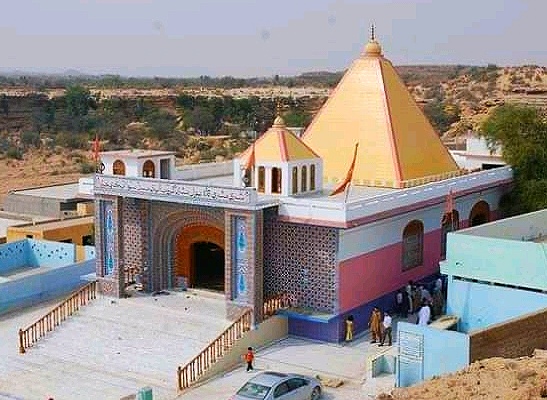|
Karampur
Karampur is a village and deh in Sehwan taluka of Jamshoro District, Sindh. Said to have been founded by the Talpur dynasty ruler Mir Karam Ali Talpur, it is located just north of Sehwan on the road to Larkano. The village contains the shrine of Hussain Shah, a Muslim saint who was buried here in the early 20th century. As of 2017, Karampur has a population of 7,303, in 1,436 households. It belongs to the tappedar circle of Channa. Around 1874, Karampur was described as a predominantly agricultural village with a small police thana. Its population was estimated to be about 1,000 people, including about 850 Muslims (mostly Utas) and 150 Hindus (mostly Lohanos). Local trade included various types of grain, ghee, milk, and butter, while the goods manufactured in Karampur mainly consisted of coarse cloth and shoes. The 1951 census recorded the village of Karampur as having an estimated population of about 1,990, in about 350 houses. It had a school at that point. In the 1990s, ... [...More Info...] [...Related Items...] OR: [Wikipedia] [Google] [Baidu] |
Jamshoro District
Jamshoro District ( sd, ضلعو ڄام شورو, ur, ), is a district of Sindh province, Pakistan. Jamshoro city is the capital while Kotri is the largest city of the Jamshoro District. The district borders Dadu district to the north. To the east, the Indus separates it from Nawab Shah, Matyari and Hyderabad districts. Thatta district lies to the south, and Karachi district to the south west. To the west, the Kheerthar Range separates it from the Sindh and Lasbela district of Baluchistan. Jamshoro District was split from Dadu District in 14th December 2004 It is situated on the west bank of River Indus. Geography The total geographical area of the district is 11,260 square kilometres. It is about 220 kilometers from north to south and about 100 kilometres wide from east to west. A 2 to 6 kilometres wide belt of the west bank of River Indus is cultivated and irrigated and the remaining land of the district is either hilly or cultivated. Agriculture is the main source of in ... [...More Info...] [...Related Items...] OR: [Wikipedia] [Google] [Baidu] |
Deh (Pakistan)
In Bangladesh, Pakistan and parts of India a mouza or mauza (also mouja) is a type of administrative district, corresponding to a specific land area within which there may be one or more settlements. Before the 20th century, the term referred to a revenue collection unit is a ''pargana'' or revenue district. The mauza system in the Indian Subcontinent is similar to the manorial system in Europe. The head of a mauza is styled as Mustajir, Pradhan or Mulraiyat, equivalent to Lord of the Manor in the manorial system. As populations increased and villages became more common and developed, the concept of the mouza declined in importance. Today it has become mostly synonymous with the ''gram'' or village. Most voter lists, for example, now use the names of villages rather than mouzas. In contemporary Pakistan, a mouza is defined as "a territorial unit with a separate name, definite boundaries, and area precisely measured and divided into plots/khasras/survey numbers." Each mouza has a ... [...More Info...] [...Related Items...] OR: [Wikipedia] [Google] [Baidu] |
Right Bank Outfall Drain
Rights are legal, social, or ethical principles of freedom or entitlement; that is, rights are the fundamental normative rules about what is allowed of people or owed to people according to some legal system, social convention, or ethical theory. Rights are of essential importance in such disciplines as law and ethics, especially theories of justice and deontology. Rights are fundamental to any civilization and the history of social conflicts is often bound up with attempts both to define and to redefine them. According to the ''Stanford Encyclopedia of Philosophy'', "rights structure the form of governments, the content of laws, and the shape of morality as it is currently perceived". Definitional issues One way to get an idea of the multiple understandings and senses of the term is to consider different ways it is used. Many diverse things are claimed as rights: There are likewise diverse possible ways to categorize rights, such as: There has been considerable debat ... [...More Info...] [...Related Items...] OR: [Wikipedia] [Google] [Baidu] |
Indus River
The Indus ( ) is a transboundary river of Asia and a trans-Himalayan river of South and Central Asia. The river rises in mountain springs northeast of Mount Kailash in Western Tibet, flows northwest through the disputed region of Kashmir, Quote: "Kashmir, region of the northwestern Indian subcontinent. It is bounded by the Uygur Autonomous Region of Xinjiang to the northeast and the Tibet Autonomous Region to the east (both parts of China), by the Indian states of Himachal Pradesh and Punjab to the south, by Pakistan to the west, and by Afghanistan to the northwest. The northern and western portions are administered by Pakistan and comprise three areas: Azad Kashmir, Gilgit, and Baltistan, ... The southern and southeastern portions constitute the Indian state of Jammu and Kashmir. The Indian- and Pakistani-administered portions are divided by a "line of control" agreed to in 1972, although neither country recognizes it as an international boundary. In addition, China became ... [...More Info...] [...Related Items...] OR: [Wikipedia] [Google] [Baidu] |
Soil Salinity
Soil salinity is the salt content in the soil; the process of increasing the salt content is known as salinization. Salts occur naturally within soils and water. Salination can be caused by natural processes such as mineral weathering or by the gradual withdrawal of an ocean. It can also come about through artificial processes such as irrigation and road salt. Natural occurrence Salts are a natural component in soils and water. The ions responsible for salination are: Na+, K+, Ca2+, Mg2+ and Cl−. Over long periods of time, as soil minerals weather and release salts, these salts are flushed or leached out of the soil by drainage water in areas with sufficient precipitation. In addition to mineral weathering, salts are also deposited via dust and precipitation. Salts may accumulate in dry regions, leading to naturally saline soils. This is the case, for example, in large parts of Australia. Human practices can increase the salinity of soils by the addition of salts in i ... [...More Info...] [...Related Items...] OR: [Wikipedia] [Google] [Baidu] |
Waterlogging (agriculture)
Waterlogging water is the saturation of soil with water. Soil may be regarded as waterlogged when it is nearly saturated with water much of the time such that its air phase is restricted and anaerobic conditions prevail. In extreme cases of prolonged waterlogging, anaerobiosis occurs, the roots of mesophytes suffer, and the subsurface reducing atmosphere leads to such processes as denitrification, methanogenesis, and the reduction of iron and manganese oxides. All plants, including crops require air (specifically, oxygen) to respire, produce energy and keep their cells alive. In agriculture, waterlogging of the soil typically blocks air from getting in to the roots. With the exception of rice (''Oryza sativa''), most crops like maize and potato, are therefore highly intolerant to waterlogging. Plant cells use a variety of signals such the oxygen concentration, plant hormones like ethylene, energy and sugar status to acclimate to waterlogging-induced oxygen deprivation. In ... [...More Info...] [...Related Items...] OR: [Wikipedia] [Google] [Baidu] |
1951 Census Of Pakistan
The Census in Pakistan ( ur, ), is a decennial census and a descriptive count of Pakistan's population on Census Day, and of their dwellings, conducted and supervised by the Pakistan Bureau of Statistics. The 2017 Census in Pakistan marks the first census to take place in Pakistan since 1998. The next census will take place in August 2022. Overview A national census is mandated by the Constitution of Pakistan to be held every ten years. After the independence of Pakistan in 1947, the first census took place in 1951 under Finance Minister Sir Malik Ghulam, serving under Prime Minister Liaquat Ali Khan. Since 1951, there have been only 6 nationwide censuses (1961, 1972, 1981, 1998 and 2017). Delays and postponements have often been due to politicization. Pakistan's last completed census took place in 2017. The next national census was scheduled to take place in 2001 and later 2008, and again in 2010, but none of those plans could materialize. There were multiple census co ... [...More Info...] [...Related Items...] OR: [Wikipedia] [Google] [Baidu] |
Ghee
Ghee is a type of clarified butter, originating from India. It is commonly used in India for cooking, as a traditional medicine, and for religious rituals. Description Ghee is typically prepared by simmering butter, which is churned from cream (traditionally made by churning the topmost layer of curd, which is also called the ''Bilona'' method), skimming any impurities from the surface, then pouring and retaining the clear liquid fat while discarding the solid residue that has settled to the bottom. Spices can be added for flavor. The texture, color, and taste of ghee depend on the quality of the butter, the milk source used in the process, and the duration of boiling time. Etymology The word ''ghee'' comes from sa, घृत (', ) 'clarified butter', from ''ghṛ-'' 'to sprinkle'. In Dravidian languages, it is also known as te, నెయ్యి '('neyyi''), ta, நெய் or துப்பகம் (''tuppakam''), ml, നെയ്യ് (''ney'') and kn, ತ� ... [...More Info...] [...Related Items...] OR: [Wikipedia] [Google] [Baidu] |
Uta (Sindhi Tribe)
Uta or UTA may refer to: Universities *University of Texas at Arlington, in the United States *University of Tarapacá, in Chile * University of Tampere, in Finland Sports * FC UTA Arad, a Romanian football club based in the town of Arad * A common abbreviation in box scores and television on-screen graphics for the American basketball team Utah Jazz Organizations *Ulster Transport Authority * Union de Transports Aériens, a defunct French airline *Union des Transports Africains de Guinée, a Guinean and Lebanese joint venture * United Talent Agency, a Hollywood talent agency * Central UTA of Monsey, a Hasidic school in Airmont, New York *United Telekom Austria * Urban Transit Authority *Utah Transit Authority, a public transportation agency * The United Companies of the Train of Artillery of the Town of Providence Places *Uta, Sardinia, a ''comune'' in the Province of Cagliari, Italy * Uta, Indonesia, a coastal village in Papua * Ūta, a village in Lithuania People * ... [...More Info...] [...Related Items...] OR: [Wikipedia] [Google] [Baidu] |
Thana
Thana means "police station" in South Asian countries, and can also mean the district controlled by a police station. * Thanas of Bangladesh, former subdistricts in the administrative geography of Bangladesh; later renamed ''upazila'' * in (British) Indian history, a ''thana'' was a group of princely states deemed too small to perform all functions separately *Thane is a city named after the word ''thana'' (police station) because it was important for its barracks back in colonial era, it is located in Konkan division, a province of India *Thana Bhawan (), also known simply as Thana, is a town in Uttar Pradesh, India See also * * {{wikt-inline, thana * Tana (other) * Thaana Thaana, Taana or Tāna ( ) is the present writing system of the Maldivian language spoken in the Maldives. Thaana has characteristics of both an abugida (diacritic, vowel-killer strokes) and a true alphabet (all vowels are written), ..., also known as Tāna, the modern writing syste ... [...More Info...] [...Related Items...] OR: [Wikipedia] [Google] [Baidu] |





